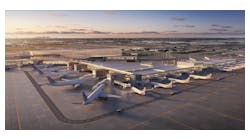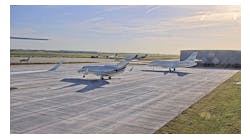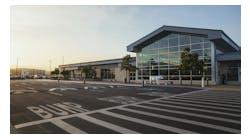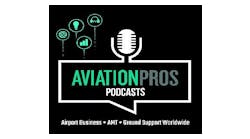Well-Equipped
Though avionics technology offers a lot desirable options, careful consideration should be given to how many "bells and whistles" are actually necessary for the aircraft
By Jim Sparks
October 2000
A manufacturer's Master Minimum Equipment List (MMEL) will often lend to the reliability of the equipment. The more equipment listed can often translate into more things to go wrong. How much time is spent in areas with special flight requirements such as Reduced Vertical Separation Minimums (RVSM)? What about the level of complexity?
The demanding expectations of business aviation require systems with high reliability for a high dispatch rate plus a balance of simplicity and sophistication. Flight deck arrangement and maintenance accessibility are two other key factors in system selection.
Modern Avionic system architecture is based on the use of advanced built-in maintenance diagnostics along with a high level of redundancy in the primary components. By utilizing integrated concepts, complex wiring is reduced resulting in less possibility of failure not to mention significant weight saving.
Glass cockpit benefits
One of the challenges encountered by the
designers of aircraft flight decks is to increase the awareness of the crew while reducing the clutter. The "Glass Cockpit" will in fact, cut pilot workload while increasing the amount of needed information for the crewmembers.
Electronic Flight Instrument Systems (EFIS) such as the Collins EFIS 4000 are comprised of four identical displays including two Primary Flight Displays (PFD) and two Multi-Function Displays (MFD).
Each pilot has the ability to control the two displays in immediate view. The PFD combines all the information included in the Basic "T," which contains:
• Barometric Altitude
• Attitude
• Airspeed
• Vertical Speed
• Horizontal Situation
When Instrument Landing is used, symbology automatically appears enabling the crew to maneuver the aircraft down the glideslope and relative to the runway centerline and can even illustrate the point where the main wheels touchdown. This data can often be shown in analog as well as digital formats. In addition to the basics, other important information such as speed cues based on Angle of Attack (AOA) and Stall margin along with acceleration monitors that enable the crew to determine engine thrust levels are at normal levels and no uncommanded braking is present. These capabilities provide the flight crew a significant increase in situational awareness. This higher level of safety is considered paramount by corporations when outfitting a business jet.
Even a single engine recreational aircraft can benefit from this technology. Even though there may not be room for four electronic displays in a small aircraft cockpit, the benefit of only two "tubes" to the pilot can be significant. In fact, EFIS Retrofit packages are currently available for many General Aviation products.
With a single propeller in the direct line of sight of the pilot, an acceleration indicator may qualify as "Bells and Whistles."
Multi-function display
capabilities
Today's Multi-Function Display (MFD) is truly appropriately named as a wide array of options may be available. Should an unlikely failure of the PFD occur, switching capabilities could be used to bring all the Essential Flight Data from the inoperative unit to the MFD.
Many business aircraft operators, as well as passenger and cargo airlines, equip their aircraft for Category II (CAT II) or Category III (CAT III) Approach and Landings. This gives the ability to land in virtual obscurity while maintaining a high degree of safety. To attain this capability, Instrument Landing equipment has to
be 100 percent redundant and include Display Comparators to bring immediate attention to any minor discrepancy in instrument displayed data. Even operating to the tight constraints of this type precision approach requires specific training on the part of the flight crew Ñ not to mention twice the level of maintenance as a non-CAT II equipped machine. With this in mind, two obvious questions would be, "How often will we require this feature?" and, "Will the number of times it is implemented justify the cost of installation plus upkeep?"
Switch to autopilot
Autopilots are another area where capabilities
need to be considered. It is not unusual to find in many high performance turbine aircraft where sophisticated Automatic Flight Control Systems (AFCS) are routinely installed. Often Yaw Damping and Mach Trim systems are needed to maintain stability while flying in the low-density air found in the upper atmosphere and cruising around 80 percent of the speed of sound. In other cases, autopilots are used for maneuvers and may be installed using a Supplemental Type Certificate (STC). These specifications need to be considered when determining how much time the aircraft will spend in conditions such as RVSM, or how many Autopilot Coupled Approaches are anticipated. Frequently, general aviation aircraft will use the autopilot as a means to provide some relief to the pilot on long flights. This can be as simple as a wing leveler or as complex as a system that could fly the aircraft from departure to destination.
Necessity or convenience?
Many companies and consultants involved
in the specification process of new aircraft are looking at the proposed usage of the machine including number of hours flown, anticipated destinations, weather trends, and how the aircraft is categorized by the prospective company to determine necessity or convenience.
Not only does non-essential equipment cost more to the aircraft owner up front, but it will also generate higher operating costs overall. Equipment not being utilized still has to be carried around. The added weight may prevent extra fuel or even an extra
revenue passenger or cargo.
Finalizing a plan
When planning an Avionic package for either
a new aircraft or even retrofitting or revising an existing system, it is always a good idea to make contact with the aircraft manufacturer or a trusted Avionics shop. Once the package is proposed, go back and justify each component. Evaluate the primary mission of the aircraft. Look at the expandability of the system. In other words, will new capabilities that come out be easily incorporated or will it require significant ground time and manpower to keep the system up?
Reliability is another key factor and communicating with other operators or technicians using or maintaining the same or similar equipment is time almost always justified.
Just because the guy in the next hangar has all the bells and whistles is not always the best justification in specifying an Avionics package. Likewise, just because some device or feature is available does not always mean it will be usable in all flight operations. The key is to do the research and plan what is genuinely needed.








